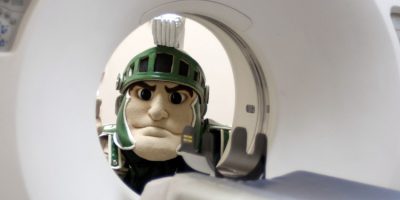As a College within one of the world's top research universities, the Michigan State University College of Veterinary Medicine enjoys numerous benefits in academics and student life that stem from the university, including a campus of nearly 50,000 students. Learn more about Michigan State here, and more about the College below.
Academics
Learn about the structure of the College's curriculum
For more information, view the course schedules for each class.
Facilities
During clinical training, students find themselves in some of the finest facilities in the country, including the renowned Veterinary Diagnostic Laboratory and the Veterinary Medical Center.
Community

Our culture is one of collaboration and leadership—students work as a team.
Students come from diverse disciplines in the basic sciences, social sciences, humanities, and medical fields and they come from many institutions from around the country and around the world. Check out profiles of some of our current classes.
Tuition
Find tuition information at the MSU Office of the Controller website.
Accreditation Status
Accreditation Status: Accredited
Accreditor: American Veterinary Medical Association
Most Recent Site Visit: 2019
Upcoming Site Visit Dates: November 8-13, 2026
-
NAVLE Pass Rate for the Class of 202585%
-
NAVLE Pass Rate for the Class of 202476%
-
NAVLE Pass Rate for the Class of 202384%
-
NAVLE Pass Rate for the Class of 202291%
-
NAVLE Pass Rate for the Class of 202194%
-
NAVLE Pass Rate for the Class of 202098%
-
NAVLE Pass Rate for the Class of 201995%
-
NAVLE Pass Rate for the Class of 2018:95%
-
NAVLE Pass Rate for the Class of 2017:97%
-
NAVLE Pass Rate for the Class of 2016:98%
-
North American Veterinary Licensing Examination (NAVLE) Minimum Acceptable Pass Rate to remain in COE Good Standing:80%
Professional Licensure and Certification
Federal regulations require MSU to publicly disclose, for each educational program designed to meet the educational requirements for a specific professional license or certification required for employment in an occupation (or advertised as meeting those requirements), information about whether program completion would meet those requirements in a state. These public disclosure requirements apply to all programs, regardless of their modality (i.e., on-ground, online, and hybrid programs). MSU discloses the required information for its Doctor of Veterinary Medicine and Veterinary Nursing Programs on pages 78-79 of the table at https://reg.msu.edu/Read/PDF/Professional Licensure and Certification - Public Disclosures - Final.pdf.
All current and prospective students are encouraged to contact the applicable professional licensure/certification boards in their respective states for additional information regarding professional licensure/certification requirements. Individuals enrolled or considering enrollment at the MSU College of Veterinary Medicine must complete two steps for licensure:
- Individuals must be a graduate of an American Veterinary Medical Association-accredited program
- Individuals must pass their national licensing exam:
- For the College’s Doctor of Veterinary Medicine Program, the required exam is the NAVLE.
- For the College’s Veterinary Nursing Program, the required exam is the VTNE.
After meeting both these requirements, individuals should apply for licensure in the state(s) for which they wish to be licensed.
The information in the table should not be construed as guaranteeing that any particular professional licensure/certification authority will approve a student’s application; nor should the information in the table be read to imply that other requirements for professional licensure/certification do not exist or that other requirements for professional licensure/certification have been determined to have been met by MSU’s program/course, or that any necessary approvals for clinical or other experiential learning placements are secured by virtue of a student’s enrollment at MSU.
State professional licensure/certification requirements are subject to change at any time.
For licensing board contact information and approval status, please see the American Association of Veterinary State Boards at aavsb.org.
If you need assistance or have any questions, please contact the appropriate program:
- For the Doctor of Veterinary Medicine Program: cvm.studentsupport@cvm.msu.edu
- For the Veterinary Nursing Program: cvm.vetnursing@cvm.msu.edu
